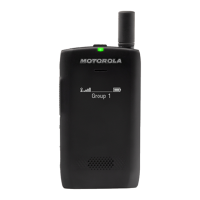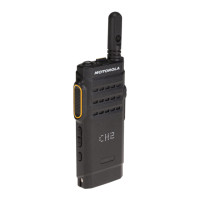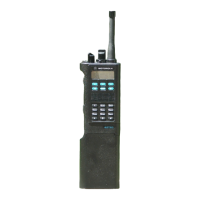If the SwMI instructs a radio to detach one of the scanned groups, the radio stops monitoring the
group, but the group remains in the scan list. Subsequent attachment of a group by the SwMI causes
the radio to begin monitoring the group again.
The SwMI may also instruct a radio to attach groups from out of the scan list. If the group attachment is
accepted, the radio monitors the group.
If talkgroups have been attached or are always attached, the radio may passively monitor the following
talkgroups:
• Selected talkgroup.
• Announcement Talkgroup (ATG) associated with the selected talkgroup (if this talkgroup is not set
as Permanently detach).
• Talkgroups associated with the selected ATG (if this talkgroup is not set as Permanently detach).
• Talkgroups in the user-activated scan list (if scanning is enabled and the SwMI-initiated detachment
has not been performed on these groups).
• Talkgroups in the SwMI-controlled scan list (if scanning is enabled).
• Talkgroups with the class of usage set to Always Scanned (if supported).
2.7.10
Priority Monitor
While the radio is active in a group call, it may receive a group call setup for a different group. The
radio decides whether to ignore the new call or accept it basing on the call priority. If the new call has
the higher priority than the current one, the new call may be joined and the current call is dropped.
The following priority types are applicable to calls:
• Call priority indicated in the call setup signaling.
• Priority of the group indicated by the Class of Usage (CoU) negotiated upon attachment.
If the old call and new call have different call priorities, the radio follows the call with the higher call
priority. If the calls have the same call priority, the CoU priority of the group decides.
If a radio is in a group call, but is not currently the talking party, and detects a call setup for a different
group with the same priority, it joins the call if a CoU priority is higher.
The radio can be set up not to immediately join the new higher priority call but to present the new call
to the user before joining it. If so provisioned, you are given a choice of following the new higher priority
call or staying with the present call.
The radio can be set up to treat a selected group call as a higher priority than a scan group call. This
behavior occurs regardless of the priority of the calls or the groups.
2.7.11
Timed Talkgroup Change
This feature allows switching between the original and the predefined Trunked Mode Operation (TMO)
or Direct Mode Operation (DMO) talkgroup by using the One-Touch Button.
The radio attaches to the selected, predefined talkgroup only for a specified amount of time
(Functional Timer). After the timer expires, the radio returns to the previously attached, original
talkgroup. Returning to the original talkgroup can also be assigned to the second press action of the
button.
Example: A campus university combines four buildings: A, B, C, and D. A security procedure
is to raise an internal alarm for the building and then notify the entire campus. The staff in each
campus building configures radios with three types of talkgroups.
MN002955A01-AA
Chapter 2: Services and Features
Send Feedback 25

